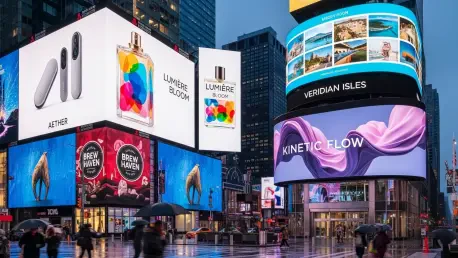Understanding the Modern Advertising Landscape
Imagine walking through a bustling city center, surrounded by towering digital billboards showcasing a favorite social media influencer endorsing a trendy new product, a scenario that is no longer a novelty but a growing reality in today’s advertising world where the lines between online engagement and real-world impact are blurring. The advertising industry has undergone a seismic shift, moving away from traditional print and broadcast methods toward digital and experiential marketing strategies that prioritize consumer connection and immediacy. This transformation is driven by the need to capture attention in an oversaturated media environment, where standing out is both a challenge and a necessity for brands.
At the heart of this evolution are two powerful forces: influencer marketing and Digital Out-of-Home (DOOH) advertising. Influencer marketing leverages the personal rapport of content creators to build trust with audiences, while DOOH uses dynamic digital displays in public spaces to command visibility. Both approaches have gained traction as essential tools for modern marketers aiming to engage consumers in meaningful ways. Their rise reflects a broader trend of prioritizing authenticity and impact over sheer volume of impressions.
Technology plays a pivotal role in merging these online and offline channels, creating seamless experiences for consumers. Major market players, including programmatic advertising platforms and digital signage providers, are driving innovation by integrating data analytics and real-time content updates into DOOH campaigns. Emerging trends, such as the use of augmented reality in public displays and the growing pool of micro-influencers, further highlight the dynamic nature of this space, setting the stage for a deeper exploration of how these elements combine to redefine advertising effectiveness.
The Power of Combining Influencers and DOOH
Synergy of Trust and Visibility
Influencer marketing has carved out a unique space in advertising by capitalizing on authenticity and relatability. Content creators, often seen as peers rather than distant celebrities, foster a sense of trust among their followers, making their endorsements feel like personal recommendations. This connection is particularly potent in a landscape where consumers are increasingly skeptical of traditional advertising tactics, seeking genuine voices to guide their purchasing decisions.
In parallel, DOOH advertising offers an unparalleled ability to capture attention through large-scale, unavoidable displays in high-traffic urban settings. Unlike online ads that can be skipped or ignored, digital billboards and screens in public spaces demand notice, embedding brand messages into the daily lives of passersby. This high-impact visibility serves as a powerful tool for amplifying reach, especially in environments where consumers are primed for spontaneous engagement.
When influencer content is integrated into DOOH formats, the result is a compelling blend of legitimacy and engagement. The familiarity of a trusted influencer’s face or message on a massive digital screen enhances credibility, while the scale of the display ensures it reaches diverse demographics. This synergy creates a memorable impression, bridging the personal touch of social media with the commanding presence of real-world advertising, ultimately driving stronger emotional connections with brands.
Measurable Impact and Market Insights
The effectiveness of combining influencers with DOOH is not just anecdotal; it is backed by compelling data that underscores its potential. Recent studies reveal that 47% of adults notice influencer content featured in out-of-home ads, with a striking 67% likely to take action—whether by visiting a website or making a purchase—after exposure. These figures demonstrate the tangible influence of this hybrid approach on consumer behavior.
Further insights show that 48% of respondents associate influencer-backed DOOH campaigns with enhanced brand quality and trustworthiness. This perception is critical in an era where authenticity often trumps flashy production values. For younger audiences like Gen Z and Millennials, who value genuine endorsements over overt sales pitches, this combination resonates deeply, positioning brands as both credible and relevant in their eyes.
Looking ahead, growth projections for DOOH as a medium are promising, with expectations of significant expansion from 2025 to 2027, fueled by advancements in programmatic buying and digital infrastructure. The particular effectiveness with younger demographics stems from their familiarity with influencer culture and their presence in urban spaces where DOOH thrives. As brands seek innovative ways to engage these key markets, the fusion of influencer content and digital displays emerges as a strategic imperative, offering measurable returns on investment.
Challenges in Merging Influencers and DOOH
The integration of influencer marketing with DOOH is not without hurdles, as brands must navigate several complexities to ensure campaign success. One primary challenge lies in adapting content across vastly different platforms; what works in a short, casual social media video may not translate effectively to a static or looping digital billboard. Maintaining a consistent brand message while tailoring visuals and tone for public displays requires careful planning and creative expertise.
Another concern is the risk of consumer skepticism toward perceived over-commercialization. When influencer content is scaled up to larger-than-life DOOH formats, some audiences may question the sincerity of the endorsement, viewing it as a purely transactional move rather than a genuine recommendation. This potential backlash underscores the importance of preserving the personal essence of influencer partnerships even in high-visibility settings.
To address these obstacles, brands can leverage technology for seamless content integration, such as using dynamic creative optimization to adapt messaging in real time. Prioritizing authentic partnerships over purely financial arrangements also helps maintain credibility, ensuring that influencers align with brand values. By focusing on storytelling that feels organic across both digital and physical media, companies can mitigate risks and maximize the impact of their campaigns.
Regulatory and Ethical Considerations
Navigating the regulatory landscape is a critical aspect of combining influencer marketing with DOOH advertising, as both fields are subject to strict guidelines. Influencer endorsements must comply with disclosure requirements, clearly indicating sponsored content to avoid misleading consumers. Similarly, DOOH campaigns must adhere to local advertising standards regarding content appropriateness and data privacy, especially when incorporating targeted or interactive elements.
Compliance with these regulations is not merely a legal obligation but a cornerstone of maintaining consumer trust. Failure to disclose partnerships or respect privacy norms can lead to reputational damage and potential fines, undermining the very authenticity that makes this advertising duo effective. Brands must stay informed about evolving rules to ensure their campaigns remain above board and resonate positively with audiences.
Ethical considerations also come into play, particularly with the large-scale nature of public displays. The visibility of DOOH means that content must be culturally sensitive and socially responsible to avoid offending diverse viewers. Transparency in influencer endorsements, coupled with a commitment to ethical messaging, ensures that campaigns contribute positively to public discourse, reinforcing brand integrity in the eyes of consumers.
Future Trends in Influencer and DOOH Advertising
As digital fatigue continues to grow among consumers overwhelmed by online ads, DOOH is poised for sustained expansion as a refreshing alternative for real-world engagement. Brands are increasingly recognizing the value of connecting with audiences in physical spaces, where distractions are fewer, and impressions are more impactful. This shift toward tangible interactions suggests a bright future for DOOH as a cornerstone of modern advertising strategies.
Emerging technologies are set to further enhance the influencer-DOOH partnership, with programmatic DOOH enabling real-time ad buying and placement based on audience data. Additionally, AI-driven content personalization can tailor influencer messages to specific locations or demographics, increasing relevance and effectiveness. These innovations promise to make campaigns more agile and targeted, ensuring they resonate with viewers on a deeper level.
The broader move toward omnichannel marketing also positions influencer-DOOH integration as a vital component of holistic consumer experiences. By creating cohesive narratives that span social media, public displays, and other touchpoints, brands can meet audiences wherever they are, influenced by global trends such as urbanization and economic shifts. This comprehensive approach not only boosts visibility but also fosters lasting connections, paving the way for sustained success in a competitive market.
Conclusion: A New Era of Brand Engagement
Reflecting on the insights gathered, it becomes evident that the combination of influencer marketing and DOOH has already transformed advertising by blending trust with unparalleled visibility. The synergy delivers actionable results, as evidenced by data showing significant consumer engagement and enhanced brand perception. This powerful duo proves particularly effective among younger demographics, who value authenticity and are more likely to respond to campaigns in urban settings.
Looking ahead, brands are encouraged to embrace this strategy by forging authentic partnerships with influencers whose values align with their own, ensuring credibility remains intact. Investing in innovative campaign execution, such as leveraging programmatic tools and personalized content, offers a pathway to stand out in crowded markets. By adopting these practices, companies position themselves to capitalize on evolving consumer behaviors and technological advancements.
The exploration also highlights the importance of staying adaptable in a rapidly changing landscape. As regulatory and ethical standards continue to evolve, maintaining transparency and cultural sensitivity in campaigns is deemed essential for long-term trust. Ultimately, this winning combination provides a roadmap for redefining brand engagement, equipping marketers with the tools to navigate future challenges and drive meaningful impact in an increasingly dynamic industry.









